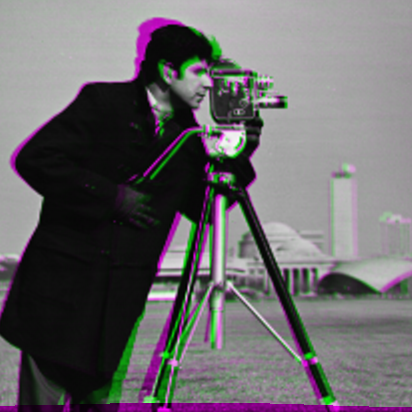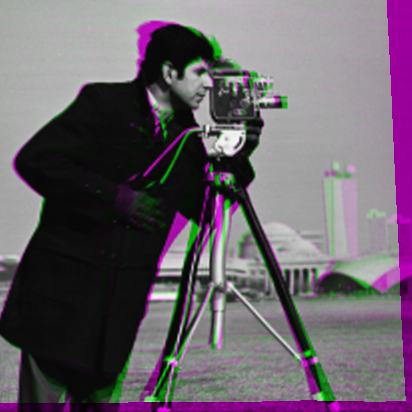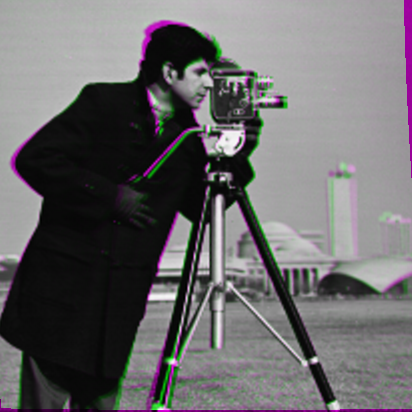Improving alignment
In the cookbook, the last timeslice was particularly poorly aligned with the fixed image. Here we explore some options for improving the results.
Adjusting λ
The value chosen by auto_λ should be viewed as a guide only; in particular, if you're registering a large data set, the fact that auto_λ runs many registrations of the same image pairs means it will take a long time. One good approach is to run auto_λ on a small subset of stacks and see what kind of values it picks; then, adopt something similar as a fixed value of λ for the whole experiment.
In practice it often seems to choose too large of a value; if we re-run the cookbook with a fixed value of λ = 1e-6, we seem to do somewhat better on that troublesome final image:

Iterative refinement
It is possible to use the solution as an initializer to iteratively improve the alignment. The idea is that
moving = img[:,:,end]
ϕ1 = ϕs[end]
movw1 = warp(moving, ϕ1)represents a closer match to fixed than moving itself; we can then calculate a ϕ2 that aligns movw1 to fixed and then compose them:
mms = mismatch_apertures(fixed, movw1, aperture_centers, aperture_width, mxshift)
for i in eachindex(mms)
E0[i], cs[i], Qs[i] = qfit(mms[i], thresh; opt=false)
end
mmis = interpolate_mm!(mms)
ϕ2, mismatch = auto_λ(cs, Qs, nodes, ap, mmis, λrange)ϕ2 should approximately align movw1 to fixed, and consequently
using Interpolations
ϕtot = interpolate(ϕ1)(ϕ2)should align moving to fixed:

You can see that this is a somewhat better alignment than our first attempt. One does not have to stop at a first iteration, one can repeat this process for as long as it continues to improve the alignment.
Changing the grid size
Another approach is to use more grid points, allowing a more fine-scaled deformation:
gridsize = (9, 9)
...
# repeat all the other calculations for the final image in the time series
...
movw = warp(moving, ϕ)
imshow(colorview(RGB, fixed, movw, fixed); name="9x9")
The "wobble" in the leg is an indication that the increasing number of degrees of freedom is making it harder to determine the correct deformation on the finest scales. It can take some experimentation to find grid sizes that work well.
RegisterHindsight
So far, every operation we've used works prospectively: we try to predict the mismatch based on shifting entire blocks of the image, and we adopt the deformation that minimizes this prospective mismatch. More conventional registration frameworks directly model the mismatch associated with moving(ϕ(x)) and perform descent on ϕ. RegisterHindsight lets you optimize ϕ in this manner:
moving, ϕ0, λ = img[:,:,end], ϕs[end], λs[end]
ϕ = interpolate!(copy(ϕ0)) # not the same as `interpolate(ϕ0)`, see docs
ap = AffinePenalty(ϕ.nodes, λ/100) # note /100! `auto_λ` often seems to choose high
p, p0 = RegisterHindsight.optimize!(ϕ, ap, fixed, moving)If you warp moving you obtain the following:

You can see this is considerably better, though of course it was far slower.
If you see the registration gets worse, it's almost surely a sign that λ was too high.